Intravision
Die Serie INTRAVISION begreift Malerei als bildgebendes Verfahren.
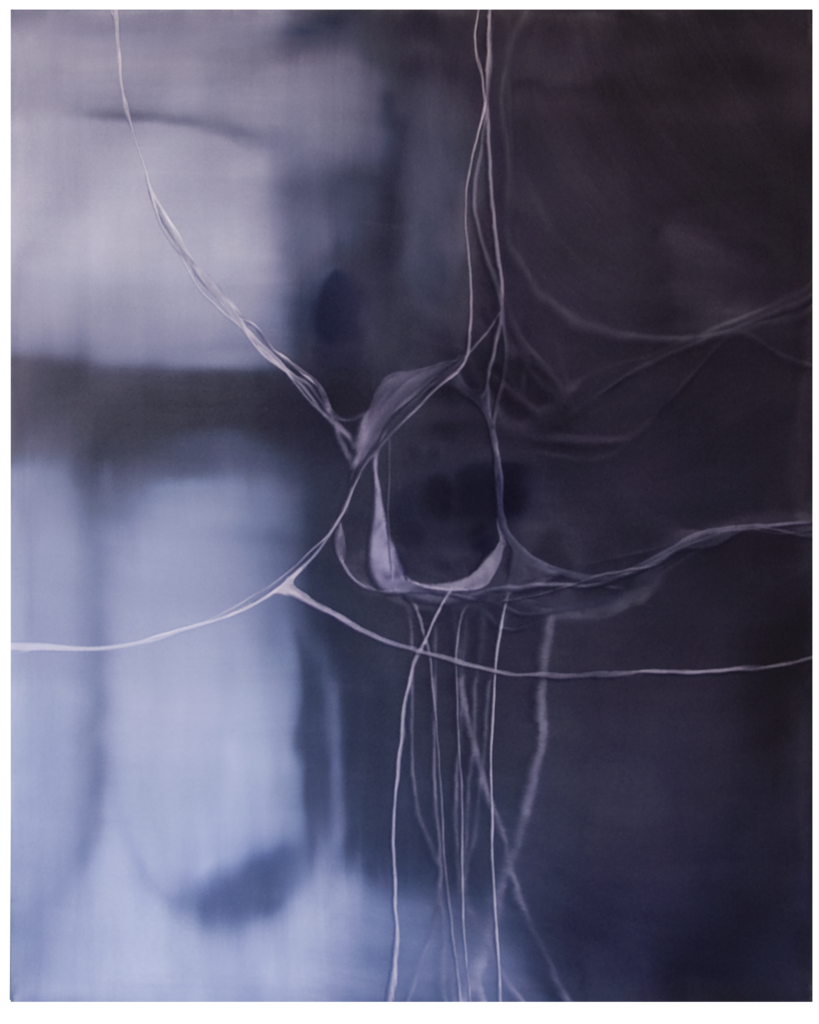
Abbildung: Oil on canvas, 165cmx145cm, INTRAVISION 2010
Die Arbeiten dieser Serie sind Beispiele der Auseinandersetzung mit der einerseits fortschreitenden computergestützten Visualisierung von Hirnaktivitäten in der Forschung und der andererseits durch das Gehirn determinierten Wahrnehmung von Wirklichkeit und Gegenständlichkeit, Struktur und Raum. Den Zusammenhang von Sehen und Wissen auszuloten ist im weitesten Sinn das Thema dieser Arbeiten. Die fiktive Offenlegung von bestimmenden Strukturen und Verknüpfungen des Denkens und Fühlens ist hierbei ein wichtiges Motiv.
Das Verhältnis zwischen Illusion und Realität dabei fließend zu bestimmen steht im Mittelpunkt des Interesses, ebenso wie die Frage nach der Erkenntnis durch das Medium Bild.

Abbildung: Oil on canvas, 165cmx195cm, INTRAVISION 2010
Somit ist diese Serie ein Beispiel für die kreative Antwort auf immer neue Bildwelten der Wissenschaften, die immer neue Erkenntnisse und Bedeutungen sichtbar machen und zugleich zeigen, wie abhängig Bilder von der Interpretation des Betrachters und dessen Vorwissen sind.
Während des Studiums, als Alleinerziehende und berufstätige Person, hatte ich oft nur Wochenenden an denen ich bis spät in die Nacht gemalt habe.
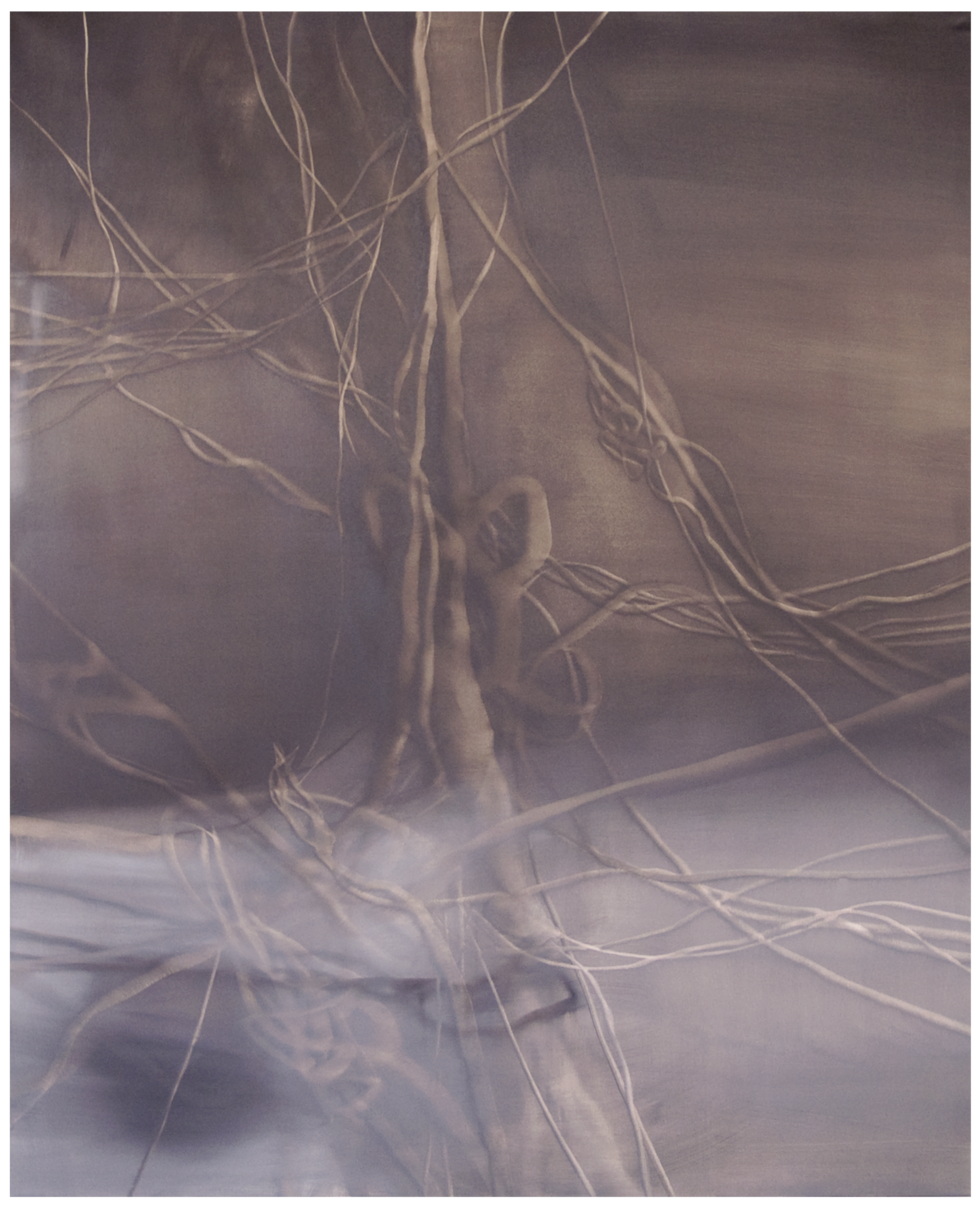
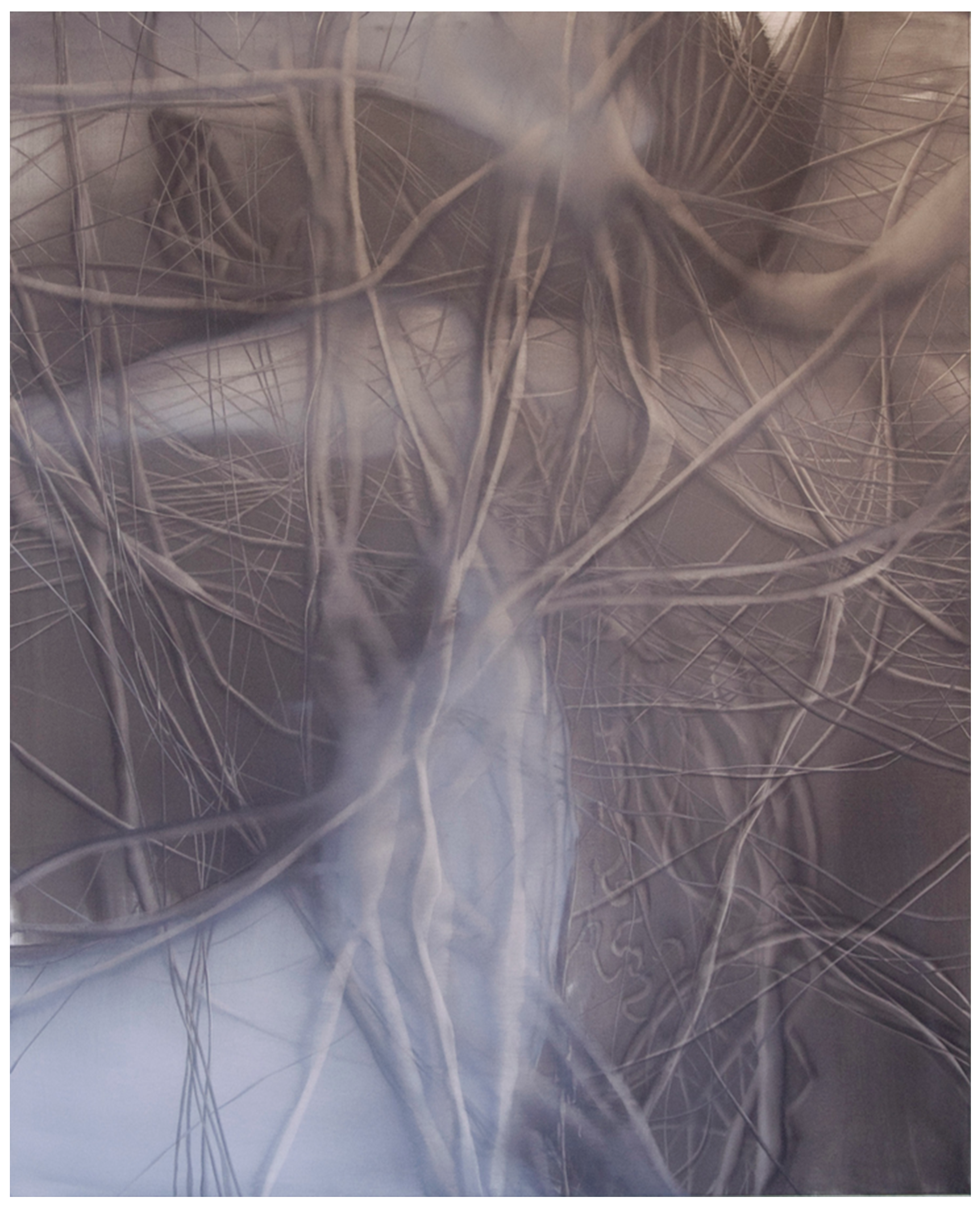
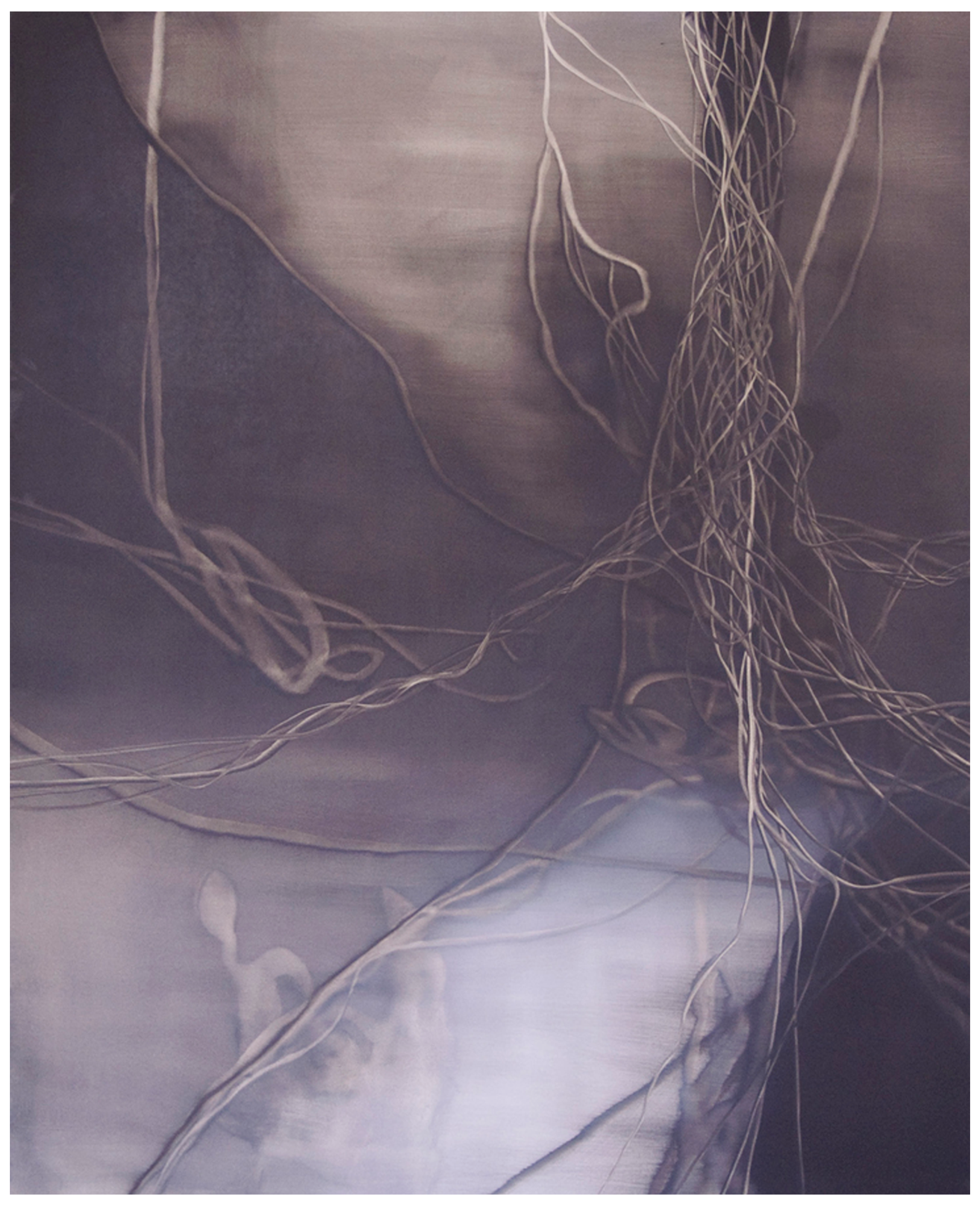
Abbildung: Triptychon, Oil on canvas, 165cmx145cm, INTRAVISION 2010
Es war mit ein Bedürfnis, eine ganzes Werk zu Ende zu bringen und in einem Fluss abzuarbeiten. Aus diesem anliegen heraus in Kombination mit dem Thema, ist die spezielle Technik und Formensprache entstanden. Die Ölfarbe wird mit sehr viel Terpentin verdünnt und Schichten können immer wieder mit Lösungsmittel in feinen Linien entfernt werden. Mit großen schnellen Pinselbewegungen werden stellen unscharf und verwaschen und Verläufe angelegt. Strukturen werden zum Schluß in die Oberfläche gemalt, mit dem feinen Pinsel fast gezeichnet, aber ebenfalls in schnellen Bewegungen. Das verlangt das Kennen der Trocknungszeiten der Farbe auf der Leinwand und schnelle Entscheidungen bei der Umsetzung. Eine Arbeit ist so in 8-10 Stunden fertig, in denen ich hoch konzentriert im Flow bin.
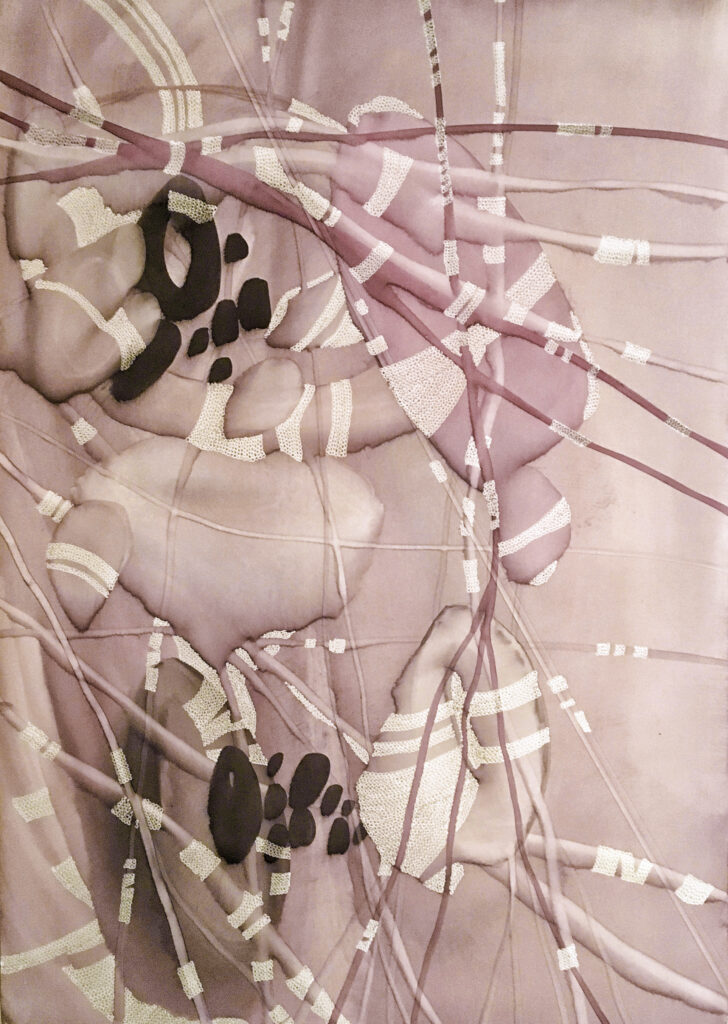
Abbildung: Watercolor and poscapen on rockpaper, DIN A 2, 2019
zur Zeit in der Galerie „Casasur“, Madrid, Spanien
Im Laufe der Jahre habe ich verschiedene Materialien erkundet, um das Thema zu bearbeiten.
Zuletzt habe ich mich nachhaltigeren und umweltfreundlichen Materialien zugewandt, die zudem erlauben Zeichnung und Malerei zu kombinieren. So ist eine ganze Serie an Arbeiten auf Steinpapier entstanden, ein Material mit extrem glatter Oberfläche, das ohne Holz und Giftstoffe produziert wird. Ich arbeite mit Wasserfarben und Tusche- oder Acrylstiften, lege erst die farbigen Formen an und strukturiere sie dann mit feinen Linien oder sehr kleinen Kreisen in schwarz oder weiß. Dadurch hat sich der Zeitraum, in dem die Arbeiten entstehen ebenfalls sehr verändert. Das spiegelt auch die Lebensumstände und die Ressourcen um meine künstlerischen Ideen umzusetzen.

Abbildung: Watercolor and poscapen on rockpaper, 150cmx100cm, 2023
Die neuen Arbeiten, die Farbe (Pinsel) und Linie/Struktur (Stift) kombinieren erlauben es, Entscheidungen seltener zu treffen, mit längeren Arbeitsphasen dazwischen. Es ist für mich eine neue und sehr komfortable Erfahrung, stundenlang an einem kleinen Ausschnitt eines Werken zu arbeiten, bevor ich eine Richtung oder Form variiere. Egal welches Material oder Technik: die Arbeiten, wachsen über die Zeit auf der Leinwand oder dem Papier, wie lebendige Organismen. Sie folgen Regeln und Bedingungen, die ich manchmal verändere oder ergänze, aber im Ganzen bleibt viel Spielraum zur intuitiven Entstehung des Bildes.
EN
The works in this series are examples of the exploration, on the one hand, of the progressive computer-aided visualization of brain activity in research, and on the other hand, of the perception of reality and materiality determined by the brain, structure, and space. In the broadest sense, the theme of these works is to explore the connection between seeing and knowing. The fictional disclosure of determining structures and connections of thinking and feeling is an important motif in this context.
The central focus of interest is to fluidly determine the relationship between illusion and reality, as well as to question the knowledge through the medium of the image.
Thus, this series is an example of the creative response to ever-evolving visual worlds of sciences, which make new insights and meanings visible, while also showing how images depend on the viewer’s interpretation and prior knowledge.
During my studies, as a single parent and a working individual, I often had only weekends when I painted late into the night.
It was a need to complete an entire work and carry it out in a continuous flow. From this intention, combined with the theme, emerged the specific technique and visual language. The oil paint is heavily diluted with turpentine, and layers can be removed again and again with solvent in fine lines. Large, rapid brush movements create blurred and washed-out areas and gradients. Structures are painted onto the surface at the end, almost drawn with a fine brush but also in swift movements. This requires knowing the drying times of the paint on the canvas and making quick decisions in execution. A piece is finished in 8-10 hours, during which I am highly concentrated in the creative flow.
Over the years, I have explored various materials to work with the theme. Lately, I have turned to more sustainable and environmentally-friendly materials, which also allow combining drawing and painting. Thus, a whole series of works on rock paper has emerged, a material with an extremely smooth surface, produced without wood or toxic substances. I work with watercolors and ink or acrylic markers, first laying down the colored shapes and then structuring them with fine lines or very small circles in black or white. This has also significantly changed the time in which the works are created. It also reflects the life circumstances and resources to realize my artistic ideas.
The new works, combining color (brush) and line/structure (pen), allow making decisions less frequently, with longer intervals of work in between. For me, it is a new and very comfortable experience to work for hours on a small section of a piece before varying a direction or form. Regardless of the material or technique used, the works grow over time on the canvas or paper, like living organisms. They follow rules and conditions that I sometimes modify or complement, but overall, there is plenty of room for the intuitive creation of the image.
ESP
Las obras de esta serie son ejemplos de la exploración, por un lado, de la progresiva visualización computarizada de la actividad cerebral en la investigación y, por otro, de la percepción de la realidad y la materialidad determinadas por el cerebro, la estructura y el espacio. En el sentido más amplio, el tema de estas obras es explorar la conexión entre ver y saber. La revelación ficticia de estructuras y conexiones determinantes del pensamiento y el sentimiento es un motivo importante en este contexto.
El enfoque principal de interés es determinar fluidamente la relación entre la ilusión y la realidad, así como cuestionar el conocimiento a través del medio de la imagen.
Así, esta serie es un ejemplo de la respuesta creativa a los cada vez más nuevos mundos visuales de las ciencias, que hacen visible nuevos conocimientos y significados, al mismo tiempo que muestran cómo las imágenes dependen de la interpretación del espectador y de su conocimiento previo.
Durante mis estudios, como madre soltera y persona trabajadora, a menudo solo tenía fines de semana en los que pintaba hasta altas horas de la noche.
Fue un deseo terminar una obra completa y trabajar en un flujo continuo. De este propósito y en combinación con el tema, surgió la técnica y el lenguaje de formas especiales. La pintura al óleo se diluye mucho con trementina y las capas pueden eliminarse una y otra vez con disolvente en líneas finas. Con grandes y rápidos movimientos de pincel, se crean áreas borrosas y difuminadas y gradientes. Las estructuras se pintan en la superficie al final, casi dibujadas con un pincel fino, pero también en movimientos rápidos. Esto requiere conocer los tiempos de secado de la pintura en el lienzo y tomar decisiones rápidas en la ejecución. Un trabajo se completa en 8-10 horas, en las que estoy altamente concentrado en el flujo creativo.
A lo largo de los años, he explorado diferentes materiales para trabajar con el tema. Últimamente, me he inclinado hacia materiales más sostenibles y respetuosos con el medio ambiente, que también permiten combinar el dibujo y la pintura. Así surgió toda una serie de trabajos en papel de piedra, un material con una superficie extremadamente lisa que se produce sin madera ni sustancias tóxicas. Trabajo con acuarelas y bolígrafos de tinta china o rotuladores acrílicos, primero creo las formas de colores y luego las estructuro con líneas finas o pequeños círculos en negro o blanco. Esto también ha cambiado mucho el tiempo en el que se crean las obras y también refleja las circunstancias de vida y los recursos para llevar a cabo mis ideas artísticas.
Las nuevas obras, que combinan el color y la línea/estructura), permiten tomar decisiones con menos frecuencia, con largas fases de trabajo en medio. Para mí, es una experiencia nueva y muy cómoda trabajar durante horas en un pequeño fragmento de una obra antes de variar una dirección o forma. Independientemente del material o técnica utilizados, las obras crecen con el tiempo en el lienzo o el papel, como organismos vivos. Siguen reglas y condiciones que a veces modifico o complemento, pero en general, hay mucho margen para la creación intuitiva de la imagen.